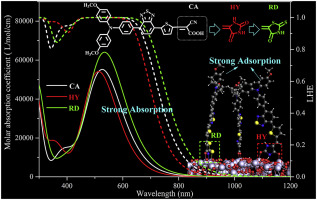Organic Electronics ( IF 3.2 ) Pub Date : 2017-12-19 , DOI: 10.1016/j.orgel.2017.12.023 Ji Zhang , Han-Cheng Zhu , Rong-Lin Zhong , Li Wang , Zhong-Min Su

|
The strong adsorption stability and significantly improved incident photon-to-current conversion efficiency (IPCE) of the new anchoring group hydantoin moiety (HY) introduced into D-A-π-A dyes for dye sensitized solar cells (DSSCs), compared with the commonly used anchoring group cyanoacrylic acid (CA), were investigated through DFT/TD-DFT calculations on the [email protected](TiO2)48 interfacial electron dynamics for the first time. It is found that the dissociative bidentate bridging mode with a hydrogen bond is the most stable adsorption configuration on the TiO2 anatase (101) surface for HY-based dyes and could produce a dramatic increase in adsorption energy compared with that of CA-based dye. Energy decomposition analysis (EDA) was performed to elucidate the different adsorption energies for the different anchoring groups with different adsorption configurations. A simplified Tamm-Dancoff density functional theory approach (sTDA-DFT), proposed by Grimme, was used to calculate the excitation energy and oscillator strength of the sensitizers after adsorption. The calculated results indicate that the adsorption mode has significant effects on the absorption spectrum. In contrast to CA-based dye, HY-based dye exhibits comparable light harvesting ability after adsorption due to the combined effects of different adsorption configurations, although the isolated dye exhibits a blue-shifted absorption spectrum. It shows a similar electron injection and dye regeneration driving force, but the significantly larger coupling between the sensitizer and the semiconductor for HY-based dye is the main reason for its improved IPCE. Moreover, to further improve the light-harvesting ability of the dyes, two other heterocyclic groups, rhodanine (RD) and 2-(3-oxo-2,3-dihydroinden-1-ylidene)-malononitrile (MT), were introduced into the dyes as anchoring groups. The results show that dyes with the RD anchoring group exhibited significantly enhanced light harvesting ability with the red-shifted absorption spectrum, higher electron injection efficiency with larger electronic coupling and strong adsorption ability; thus, it is worthy of experimental synthesis for use in high-performance dye sensitized solar cells.
中文翻译:

具有优异的吸附稳定性和改进的IPCE的高效率非羧基染料敏化太阳能电池有望的杂环锚固基:理论研究
与常用染料相比,引入DA-π-A染料的新型锚定基乙内酰脲部分(HY)具有较强的吸附稳定性,并显着提高了入射光子-电流转换效率(IPCE),该染料用于染料敏化太阳能电池(DSSC)通过DFT / TD-DFT计算,首次在[电子邮件保护](TiO 2)48界面电子动力学上研究了锚固基团氰基丙烯酸(CA)。发现具有氢键的离解性双齿桥接模式是HY在TiO 2锐钛矿(101)表面上最稳定的吸附构型基染料,与基于CA的染料相比,可产生更大的吸附能。进行了能量分解分析(EDA),以阐明具有不同吸附构型的不同锚固基团的不同吸附能。由Grimme提出的简化的Tamm-Dancoff密度泛函理论方法(sTDA-DFT)用于计算吸附后敏化剂的激发能和振子强度。计算结果表明,吸附方式对吸收光谱有显着影响。与基于CA的染料相反,HY尽管分离的染料表现出蓝移的吸收光谱,但由于不同的吸附构型的组合作用,基于染料的染料在吸附后表现出可比的光收集能力。它显示了相似的电子注入和染料再生驱动力,但是用于HY基染料的敏化剂与半导体之间的显着更大的耦合是其IPCE改善的主要原因。此外,为了进一步提高染料的光吸收能力,将另外两个杂环基罗丹宁(RD)和2-(3-氧代-2,3-二氢茚基-1-亚烷基)-丙二腈(MT)引入其中。染料作为锚定基团。结果表明染料具有RD锚定基团的吸收光谱具有红移吸收光谱,电子注入效率更高,电子耦合更大,吸附能力强。因此,值得用于高性能染料敏化太阳能电池的实验合成。


























 京公网安备 11010802027423号
京公网安备 11010802027423号